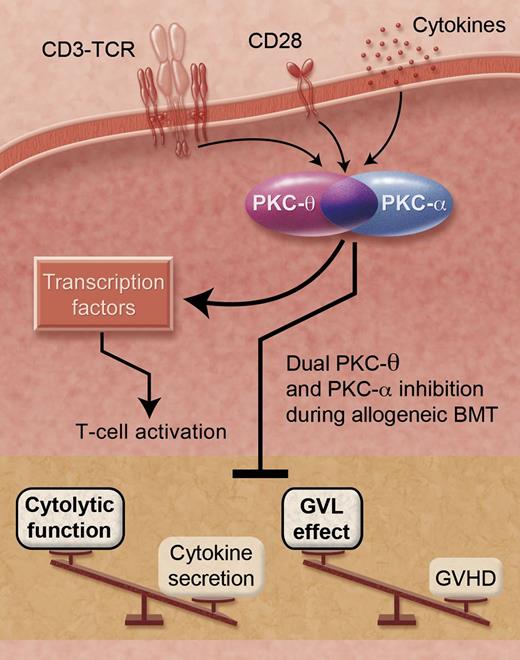In this issue of Blood, using genetically deficient donor T cells or posttransplant pharmacologic inhibition, Haarberg et al have conclusively demonstrated that protein kinase C (PKC)-θ and PKC-α each contribute to alloreactivity after experimental allogeneic bone marrow transplantation (BMT).1
Dual PKC-θ and PKC-α inhibition improves experimental allogeneic BMT. After activation through the CD3-TCR (T-cell receptor) complex, CD28 pathway, or cytokines, PKC-θ and PKC-α play both unique and overlapping roles that culminate in the induction of multiple transcription factors necessary for T-cell activation. Donor T cells deficient in both PKC-θ and PKC-α or post-BMT therapy with a drug that inhibits both PKC-θ and PKC-α led to a profound reduction in inflammatory cytokine secretion with relative preservation of cytolytic function and a GVL effect coincident with markedly reduced GVHD. Professional illustration by Alice Y. Chen.
Dual PKC-θ and PKC-α inhibition improves experimental allogeneic BMT. After activation through the CD3-TCR (T-cell receptor) complex, CD28 pathway, or cytokines, PKC-θ and PKC-α play both unique and overlapping roles that culminate in the induction of multiple transcription factors necessary for T-cell activation. Donor T cells deficient in both PKC-θ and PKC-α or post-BMT therapy with a drug that inhibits both PKC-θ and PKC-α led to a profound reduction in inflammatory cytokine secretion with relative preservation of cytolytic function and a GVL effect coincident with markedly reduced GVHD. Professional illustration by Alice Y. Chen.
These PKC isoforms, which belong to a broader family of PKC proteins that transduce extracellular signals that dictate key cellular functions such as proliferation and differentiation, act within T cells downstream to T-cell receptor and CD28 activation. Relative to recipients of single PKC-θ–deficient donor T cells, Haarberg et al found that recipients of dual PKC-θ/PKC-α–deficient T cells had improved protection against graft-versus-host disease (GVHD) but still benefitted from a graft-versus-leukemia (GVL) effect. Remarkably, post-BMT therapy with a drug (R524) that potently inhibits PKC-θ/PKC-α while largely sparing other kinases mimicked the gene knockout results for an improved balance of GVHD and GVL effects.
The current results therefore advance an understanding of the PKC signaling pathway after experimental allogeneic BMT, which previously focused on the role of PKC-θ in balancing GVHD and GVL effects.2 It has been previously shown that PKC-θ and PKC-α make both unique and overlapping contributions to T-cell signaling and to the capacity of murine hosts to reject cardiac allografts.3 The study by Haarberg et al, therefore, has successfully addressed the key question of whether similar cooperativity exists between these PKC isoforms after allogeneic BMT.
Dual targeting of PKC-θ and PKC-α led to marked inhibition of inflammatory cytokines post-BMT, with relative preservation of allogeneic T-cell cytolytic function. It is possible, as the authors have proposed, that differential modulation of cytolytic vs cytokine function may help account for an ability of dual PKC inhibition to potently prevent GVHD while permitting a GVL effect (see figure); additional experiments using T cells deficient in cytolytic molecules may further clarify this potential mechanism of action. In light of the known role of the PKC pathway in diverse tumors including melanoma4 and diffuse large B-cell lymphoma,5 it may also be possible that the GVL effect achieved during PKC inhibition might relate to a direct effect of the PKC inhibitor on the tumor cells; the investigators went to substantial lengths to evaluate this possibility and found no evidence for a direct antitumor effect in vitro or in vivo after syngeneic BMT. However, PKC inhibition can lower the apoptotic threshold of chronic lymphocytic leukemia cells to various cell death triggers6 ; as such, it seems possible that PKC modulation of tumor cell biology, when combined with allogeneic cytotoxic T cells, might synergize for the mediation of GVL effects.
Although it will be interesting to further explore the mechanisms accounting for the ability of PKC inhibition to separate a GVL effect from GVHD, it is important to consider a clinical translation given the survival benefit observed in the current experimental studies and the ongoing clinical obstacles of GVHD and tumor progression. It should be noted that clinical translation of PKC inhibitors for the prevention of solid organ allograft rejection has not been straightforward in spite of robust murine model data3 and favorable results in a nonhuman primate model.7 That is, in a phase 2 study involving kidney transplant recipients who received a common immune suppression backbone regimen (basiliximab, everolimus, and prednisone), recipients of additional therapy with a PKC inhibitor (sotrastaurin) had increased adverse events and graft failure relative to recipients of additional therapy with cyclosporine.8 In a separate clinical trial, recipients of tacrolimus plus sotrastaurin had increased adverse events and a similar rate of allograft failure relative to recipients of tacrolimus plus mycophenolic acid.9 Further experimental models and clinical trials will need to compare various PKC inhibitory compounds, particularly with respect to optimal use in conjunction with standard immunosuppressive agents. It is possible that allogeneic BMT may represent a favorable clinical setting for the PKC inhibitors due to safety considerations (potential ability to use lower drug dosing to modulate rather than extinguish alloreactivity) and efficacy considerations (potential for direct or synergistic antitumor effects). The impressive results offered by Haarberg et al will hopefully fuel continued investigations to identify a niche for modulation of the PKC pathway in transplantation medicine.
Conflict-of-interest disclosure: The author declares no competing financial interests.


This feature is available to Subscribers Only
Sign In or Create an Account Close Modal